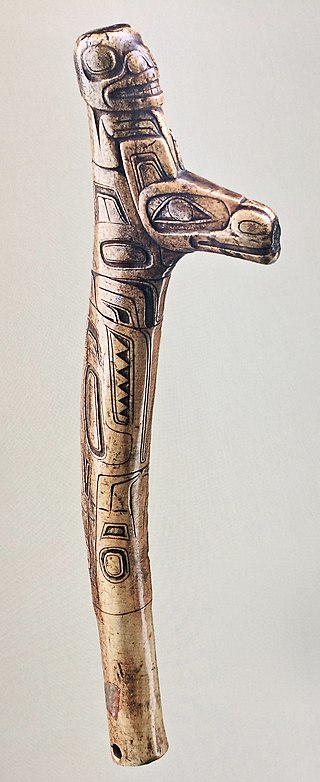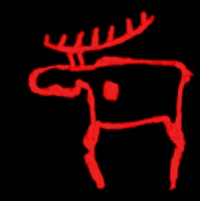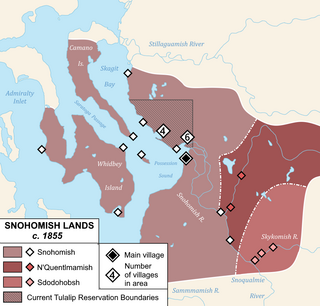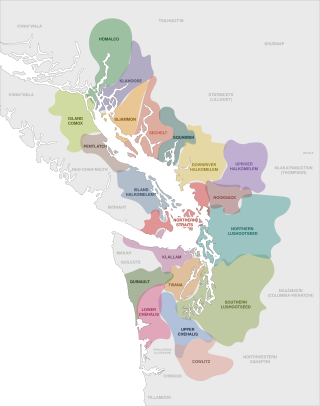
Shamanism or samanism is a religious practice that involves a practitioner interacting with the spirit world through altered states of consciousness, such as trance. The goal of this is usually to direct spirits or spiritual energies into the physical world for the purpose of healing, divination, or to aid human beings in some other way.

The Tlingit or Lingít are Indigenous peoples of the Pacific Northwest Coast of North America and constitute two of the 231 federally recognized Tribes of Alaska. Although the majority, about 14,000 people, are Alaska Natives, there is a small minority, 2,110, who are Canadian First Nations.

Tsimshian mythology is the mythology of the Tsimshian, an Aboriginal people in Canada and a Native American tribe in the United States. The majority of Tsimshian people live in British Columbia, while others live in Alaska.
This article is about the spiritual beliefs, histories and practices in Kwakwaka'wakw mythology. The Kwakwaka'wakw are a group of Indigenous nations, numbering about 5,500, who live in the central coast of British Columbia on northern Vancouver Island and the mainland. Kwakwaka'wakw translates into "Kwak'wala-speaking tribes." However, the individual tribes are single autonomous nations and do not view themselves collectively as one group.

In European folklore of the medieval and early modern periods, familiars were believed to be supernatural entities, interdimensional beings, or spiritual guardians that would protect or assist witches and cunning folk in their practice of magic, divination, and spiritual insight. According to records of the time, those alleging to have had contact with familiar spirits reported that they could manifest as numerous forms, usually as an animal, but sometimes as a human or humanoid figure, and were described as "clearly defined, three-dimensional... forms, vivid with colour and animated with movement and sound", as opposed to descriptions of ghosts with their "smoky, undefined form[s]".

Astral projection is a term used in esotericism to describe an intentional out-of-body experience (OBE) that assumes the existence of a subtle body, known as the astral body or body of light, through which consciousness can function separately from the physical body and travel throughout the astral plane.

Baltic Finnic paganism, or BalticFinnic polytheism was the indigenous religion of the various of the Baltic Finnic peoples, specifically the Finns, Karelians, Estonians, Vepsians and Izhorians, prior to Christianisation. It was a polytheistic religion, worshipping a number of different deities. The chief deity was the god of thunder and the sky, Ukko; other important deities included Jumala, Ahti, and Tapio. Jumala was a sky god; today, the word "Jumala" refers to a monotheistic God. Ahti was a god of the sea, waters and fish. Tapio was the god of the forest and hunting.

The Snohomish people are a Lushootseed-speaking Southern Coast Salish people who are indigenous to the Puget Sound region of Washington State. Most Snohomish are enrolled in the Tulalip Tribes of Washington and reside on the reservation or nearby, although others are enrolled in other tribes, and some are members of the non-recognized Snohomish Tribe of Indians. Traditionally, the Snohomish occupied a wide area of land, including the Snohomish River, parts of Whidbey and Camano Islands, and the nearby coastline of Skagit Bay and Puget Sound. They had at least 25 permanent villages throughout their lands, but in 1855, signed the Treaty of Point Elliott and were relocated to the Tulalip Reservation. Although some moved to the reservation, the harsh conditions, lack of land, and oppressive policies of the United States government caused many to leave.

Twana is the collective name for a group of nine Coast Salish peoples in the northern-mid Puget Sound region. The Skokomish are the main surviving group and self-identify as the Twana today. The spoken language, also named Twana, is part of the Central Coast Salish language group. The Twana language is closely related to Lushootseed.
Bakwas is one of the supernatural spirits of the Kwakwaka'wakw people of coastal British Columbia. He is often called "wild man of the woods." He eats ghost food out of cockle shells and tries to offer this to living humans who are stranded in the woods, in order to bring them over to the ghost world. If the human were to eat this food, it would turn them into a being like the bakwas. He lives in an invisible house in the forest and the spirits of the drowned congregate there. In some myths he is described as the consort of dzunukwa, and the father of her children.

Traditional Alaskan Native religion involves mediation between people and spirits, souls, and other immortal beings. Such beliefs and practices were once widespread among Inuit, Yupik, Aleut, and Northwest Coastal Indian cultures, but today are less common. They were already in decline among many groups when the first major ethnological research was done. For example, at the end of the 19th century, Sagdloq, the last medicine man among what were then called in English, "Polar Eskimos", died; he was believed to be able to travel to the sky and under the sea, and was also known for using ventriloquism and sleight-of-hand.

The Coast Salish are a group of ethnically and linguistically related Indigenous peoples of the Pacific Northwest Coast, living in the Canadian province of British Columbia and the U.S. states of Washington and Oregon. They speak one of the Coast Salish languages. The Nuxalk nation are usually included in the group, although their language is more closely related to Interior Salish languages.

The sisiutl is a legendary creature found in many cultures of the Indigenous peoples of the Pacific Northwest Coast, notably the Kwakwakaʼwakw. Typically, it is depicted as a double-headed sea serpent. Sometimes, the symbol features an additional central face of a supernatural being. The sisiutl features prominently in Pacific Northwest art, dances and songs. The sisiutl is closely associated with shamans because both are seen as mediators between the natural and supernatural worlds.
The philosophy and religion of the Tlingit, although never formally codified, was historically a fairly well organized philosophical and religious system whose basic axioms shaped the way all Tlingit people viewed and interacted with the world around them. Between 1886 and 1895, in the face of their shamans' inability to treat Old World diseases, including smallpox, many Tlingit people converted to Orthodox Christianity. It has been argued that they saw Eastern Orthodox Christianity as a way of resisting assimilation to the "American way of life", which was associated with Presbyterianism. Russian Orthodox missionaries had translated their liturgy into the Tlingit language. After Christianization, the Tlingit belief system began to erode.
Mythic humanoids are legendary, folkloric, or mythological creatures that are part human, or that resemble humans through appearance or character. Each culture has different mythical creatures that come from many different origins, and many of these creatures are humanoids. They are often able to talk and in many stories they guide the hero on their journey.
The Nahua of La Huasteca is an indigenous ethnic group of Mexico and one of the Nahua peoples. They live in the mountainous area called La Huasteca which is located in north eastern Mexico and contains parts of the states of Hidalgo, Veracruz and Puebla. They speak one of the Huasteca Nahuatl dialects: western, central or eastern Huasteca Nahuatl.

The Jivaroan peoples are the indigenous peoples in the headwaters of the Marañon River and its tributaries, in northern Peru and eastern Ecuador. The tribes speak the Chicham languages.
Vegetalismo is a term used to refer to a practice of mestizo shamanism in the Peruvian Amazon in which the shamans—known as vegetalistas—are said to gain their knowledge and power to cure from the vegetales, or plants of the region. Many believe to receive their knowledge from ingesting the hallucinogenic, emetic brew ayahuasca.

Shamanism among Alaska Natives was particularly important as it served to construct their special connection to their land, and a kinship with the animals with whom they share that land. Before the introduction of western culture and the religions that are now practiced in Alaska, there was a common spiritual connection made with the people to the land they occupied. The most common name for this connection is shamanism. Shamanism differs in every culture where it is practiced, in Alaska it is centered in the animals that are common in the area. Through the use of many myths, stories, and ceremonies these animals are personified and their spirits made tangible and in turn are deeply woven within the Native Alaska people today. It was through the shaman that the spirit world was connected to the natural world. A shaman in Alaska Native culture was a mediator, healer and the spirit worlds’ mouthpiece. Although shamanism is no longer popularly practiced, it was and continues to be the heart of the Native Alaskan people.

The Durin-gut, also called the Michin-gut and the Chuneun-gut, is the healing ceremony for mental illnesses in the Korean shamanism of southern Jeju Island. While commonly held as late as the 1980s, it has now become very rare due to the introduction of modern psychiatry.














